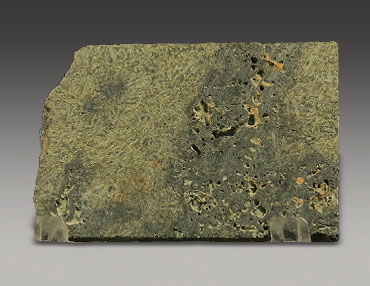
Martian Meteorite NWA 11288
Shergottite (Martian origin)
Northwest Africa, 2015.
For decades, most meteorite specialists thought the source of all meteorites was the asteroid belt situated between the planets Mars and Jupiter. The launch of the two Viking landers in 1976 changed all that. Data that came back from the Mars surface indicated the chemical makeup of the Martian rocks and soil. This information was then compared to the research done on several meteorites of questionable origin. The data matched, conclusively determining that meteorites from the surface of Mars were on Earth.
Of the 61,000 meteorites known on Earth, only 224 are from Mars. These have been further classified into three main groups — shergottites, nakhlites, and chassignites. About 75% of meteorites from Mars are shergottites.
How did these rocks from Mars get off the planet?

These rocks were likely jettisoned into space when an asteroid struck the planet at a shallow angle, driving rock and soil into their atmosphere. Since the gravity on Mars is about 38% of Earth’s, surface material could pass through their atmosphere and into space. From there, it may take millions of years for the rock to enter Earth’s atmosphere, survive its fiery entry, and then land somewhere on the 29% of Earth that isn’t water.
On rare occasions, the asteroid strikes the planet with such force that the collision generates enough heat to melt the asteroid rock into the planetary rock. This process is called an impact melt. Even rarer still is when small cavities of gasses, or vugs, are found in these impact melt meteorites.
The museum’s slice is from Martian meteorite NWA 11288, which was discovered in Northwest Africa near Morocco in 2015. It is a shergottite impact melt as indicated by the darker layer, as well as exhibiting vugs that may have once contained the atmosphere of Mars.
This specimen was acquired for the museum from Aerolite Meteorites of Tucson, Arizona.